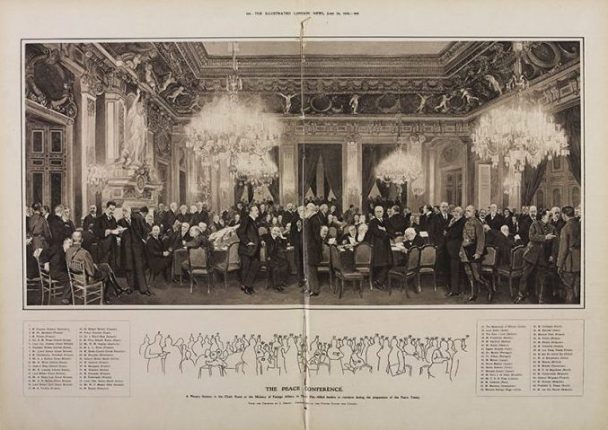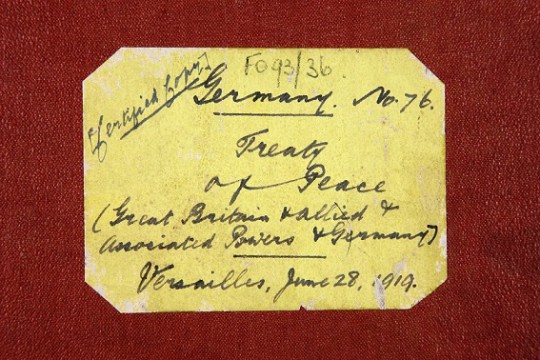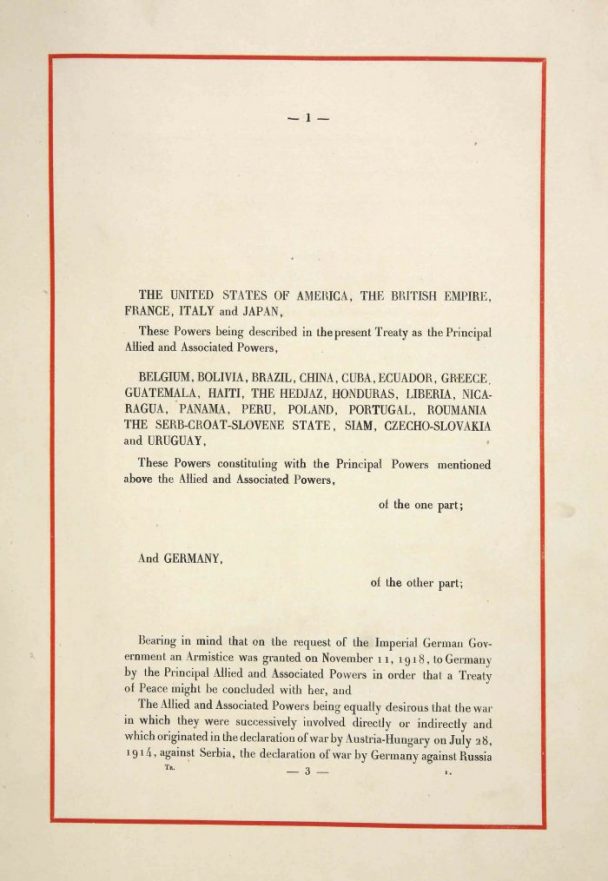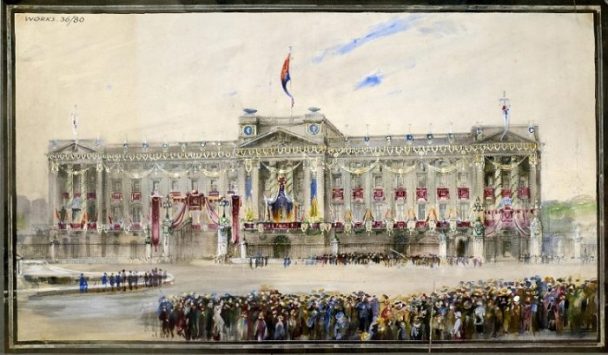On Monday 18 January, two months after the armistice was signed with Germany, a peace conference opened in Paris. It was only meant to last for two or three months, but in the end it went on for more than six.
Ten committees were set up to establish the principal terms and the issues that would end up as terms in the peace treaty. These included a committee to establish the formation of a League of Nations, a point insisted upon by President Woodrow Wilson as a pre-condition for peace. There were also committees to settle the boundaries with Germany, to establish financial penalties, to deal with reparations, to settle military, naval and air clauses, and to resolve issues regarding navigation, trade and labour.
The overarching decisions were made by a Council of Four, composed of leaders of the ‘Big Three’ powers: David Lloyd George of Great Britain, Georges Clemenceau of France, and Thomas Woodrow Wilson of America, as well as the Italian Premier, Vittorio Orlando, and their foreign ministers.

The Peace Conference: Illustrated London News, 28 June 1919. Catalogue reference ZLIB 34/154.
The image above shows a plenary session of the Peace Conference, which took place in the Clock Room at the Ministry of Foreign Affairs in Paris. Delegates of all nations that had taken an active part in the war on behalf of the Allies were entitled to send representatives. Among the most noted was the composer Ignace Paderewski, newly elected as Prime Minister of Poland. He is seated towards the centre of the drawing, while the leaders of the ‘Big Three’ powers are standing together towards the left of the image.
The Treaty of Versailles
The long and intense negotiations resulted in an agreement containing 440 articles in 15 parts, with numerous annexes. The treaty set out the terms and conditions agreed at the conference, officially ending the war.

The front cover of our copy of The Treaty of Versailles. Catalogue reference FO 93/36/76.
The peace treaty between the Allied and Associated Powers and Germany was signed on Saturday 28 June in the galerie des Glaces at Versailles, in the very room in which the German Empire was proclaimed in 1871.

The opening paragraphs of the Treaty of Versailles. Catalogue reference FO 93/36/76.
The treaty begins with a covenant establishing the League of Nations, before moving on to more particular, punitive clauses concerning the cession of land, recognition of guilt, disarmament and war reparations.
The treaty required a much reduced and demilitarised Germany to pay an initial sum of 200 million gold marks, as well as making reparations and restitution in terms of cash and livestock and mineral resources. Germany would lose all of her colonies, and had to accept trade restrictions and the exploitation of trade to the benefit of the Allied powers. To guarantee the treaty, zones of occupation were to be set up with phased withdrawals upon meeting key milestones.
Under Article 231 of the Treaty of Versailles, Germany had to acknowledge responsibility for all the loss and damage to which the Allied and associated governments and their nationals had been subjected as a consequence of the war imposed upon them by German aggression. The Treaty imposed punitive reparations, with Germany required to pay 132 billion gold marks (US$33 billion) to cover civilian damage caused during the war.
Some clauses were never put into effect. Article 227 called for Kaiser Wilhelm II to be put on trial. Since he had abdicated, and was already in exile, this clause was eventually dropped. Nevertheless the German people saw reparations as a national humiliation and came to see themselves as victims.
The uncompromising terms of the Versailles Treaty undermined the legitimacy of the newly elected Weimar government. This opened it to attack from the extreme right and left. Communist, nationalist and fascist movements in Germany grew in strength and began to enjoy a new level of popularity.
The denunciation of the Versailles Treaty was one of the platforms that gave Hitler’s Nazi Party credibility with mainstream voters in the early 1920s and early 1930s. Only one signed copy of the treaty was made, which was deposited in the archives of the French Republic. Authenticated copies were transmitted to the signatory powers. The copy held at The National Archives is the authenticated British copy, signed off at the end by Stephen Pichon, the French Foreign Minister.
Separate peace settlements were signed later with Austria, Bulgaria, Hungary, and Turkey. These treaties, signed at St. Germain-en-Laye, Neuilly, Trianon, Sevres and Lausanne will be examined in later blogs.
Celebrations
King George V, addressing parliament and through them the nation, declared that ‘This formal act brings to its concluding stages the terrible war which has devastated Europe and distracted the world. It manifests the victory of the ideals of freedom and liberty for which we have made untold sacrifices. I share my people’s joy and thanksgiving, and earnestly pray that the coming years of peace may bring to them ever-increasing happiness and prosperity.’ (ZPER 34/155)

Peace Celebrations 1919. Watercolour perspective view of east front of Buckingham Palace with decorations and emblems. Catalogue reference: WORK 36/80
To celebrate and mark the end of the war officially, a bank holiday was declared by foreign secretary Lord Curzon. A victory parade was organised in London on 19 July 1919, with similar celebrations taking place across Great Britain and her colonies. Nearly 15,000 troops took part in the parade, led by General Pershing (head of the US Expeditionary Force), Marechal Foch (Allied supreme commander) and Field Marshal Haig (British commander-in-chief).

Victory parade, London 19 July 1919. Catalogue reference WORK 21/74
A monument to the fallen, designed by Sir Edwin Lutyens, was hastily erected in Whitehall, and was originally a temporary construction of wood and plaster. A more permanent construction of the same design, made from Portland Stone, replaced it in 1920.
Visit The National Archives
The National Archives holds 310 volumes of correspondence and papers of the British delegates at the Paris Peace Conference, in the series FO 608. They are a very underused resource and yet they can tell us a great deal about the negotiation process at the conference. They also show the evolution of some of the more controversial clauses which resulted in a treaty that was described by John Maynard Keynes, who had attended the peace conference, as a ‘Carthaginian peace’, a brutal peace imposed with the aim of crushing the enemy.
There are also published reports of the conference commissions in the series FO 374, and minutes and papers of proceedings may be found in the series CAB 29. Finally, a book display has been put together by our Library team, and this may be seen in our Research and Enquiries Room.
Online sources
War Cabinet minutes and memoranda contain a wealth of information about the Treaty of Versailles and the Paris Peace Conference. You can search through the papers and download the documents here.
The global impact of the First World War can be explored through our interactive map, which highlights key events and figures in countries from Aden to Zanzibar. Drawn directly from our records at The National Archives, the map goes beyond the trenches of the Western Front and shows how the war affected different parts of the world.
On our education pages you will also find sources for teachers and pupils under the heading ‘making peace’.
Take part in the conference
On 27 and 28 June, The National Archives, in association with FCO Historians, the University of Strathclyde, the Department of International History at LSE and the British International History Group, is running a two-day conference. Find out more.
For programme details and to book your place, visit our Eventbrite page. Conference delegates will have a rare opportunity to see all of the authenticated copies of the First World War treaties together.